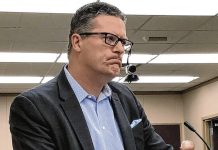Columbus has a great success story to tell, one that involves the ongoing pursuit of excellence — a quality that will be important as the city faces new challenges, an urban issues expert said.
Aaron Renn, a senior fellow at the Manhattan Institute for Policy Research in New York, discussed Columbus’ success and challenges during his keynote speech before 530 people attending the Columbus Area Chamber of Commerce’s annual meeting Wednesday at the Clarion Hotel and Conference Center.
He noted how Columbus has outpaced the state and nation in job growth since 1990, and has hung close — although slightly below — the national average for personal income while the state has fallen further behind over the past 15 years.
Success can be attributed in part to the vision of former Cummins Inc. chairman and philanthropist J. Irwin Miller, and the success of the company he led.
The Cummins Foundation, for example, paid the architectural fees for world-renowned architects to design new school buildings in the city, part of an effort to attract talent to the small Midwestern community.
But other communities, such as Muncie with the Ball Corporation, have also had large corporations and families or individuals as benefactors and have not fared as well over the long term, the Indiana University graduate said.
The difference lies in a community value, said Renn, a native of the small community of Laconia along the Ohio River.
“In Columbus, excellence and the pursuit of excellence are respected in a way that, candidly, they have not always been in the rest of the state of Indiana,” said Renn, who visited Columbus as a child and also a few years ago was part of a bloggers tour set up by the Columbus Area Visitors Center to highlight the city’s architectural gems.
The quality that makes Columbus special is important because too often Indiana hasn’t pursued excellence, which he said is a turnoff to people who desire more.
“People want to live in a place where their civic aspiration matches their personal aspiration,” Renn said.
The days of being average in skills, quality of production and education and still having a middle-class life are over, Renn said.
“In the 21st century we live in, only excellence is going to be able to survive the brutal global competition,” Renn said.
“Which workers are more likely to produce excellence? Workers who demand excellence in their own communities, or ones who accept mediocrity in the place they and their own family live?”
Renn said it’s notable and not surprising that more Japanese businesses are located in Columbus than any other Hoosier city except Indianapolis. That’s because Japanese businesses are known for producing quality products, and have a deep appreciation of architecture and design. Columbus is world-renowned for its architecture.
Columbus’ success has the potential to breed more success, and the city should make a greater effort in marketing to articulate its model to others, Renn said.
The city has a large reliance on manufacturing, as do many other Hoosier cities.
But Columbus’ ability to sell its story will become increasingly important with the rise of urbanization in the U.S., he said.
Millennials, many of whom have the technological skills sought by employers, are often choosing to live in urban areas because those settings match their civic interests. Consequently, some large companies have been moving parts of their businesses to the downtown districts of large cities to go where the talent is, Renn said.
Columbus would benefit in its efforts to attract talent by comparing its amenities to what communities such as Indianapolis offer, and assess whether they have enough or need to improve their quality, Renn said.
The city’s downtown is a prime area to create its own urban node, he said.
Cindy Frey, president of the Columbus Area Chamber of Commerce, said after the meeting that Renn’s thoughts were on-point and served as a reminder that the community’s legacy is its longstanding commitment to excellence.
She said the personal income numbers Renn presented were a bit of concern, but that the community was taking steps — such as with education and business — to improve.
And with a new city administration, it’s a good time to reassess and envision what the community might be able to accomplish, Frey said.
“I think we’re primed to continue to strive for success,” she said.
Kathy Oren, executive director of the Community Education Coalition, said she was struck by Renn’s suggestion that Columbus market its successful model across the state to help the state.
“We’re doing that in the region with the Education Coalition serving 10 counties, and the model of how we work together and work with our neighbors in southeastern Indiana,” Oren said after the meeting.
She noted that John Burnett, CEO of the Community Education Coalition, and Jack Hess, executive director of the Institute for Coalition Building, dedicate a lot of time to helping other communities try to establish education coalitions.
“We do well when our neighbors do well and Columbus does well when the state of Indiana does well,” Oren said.




